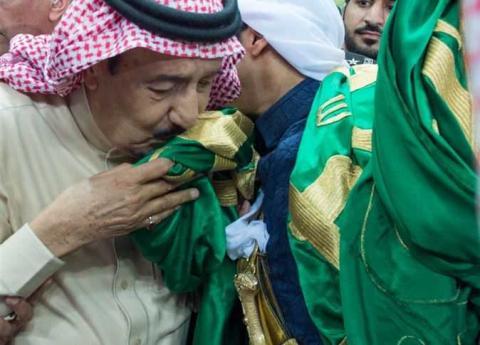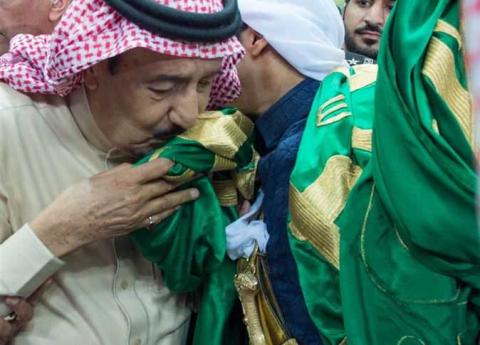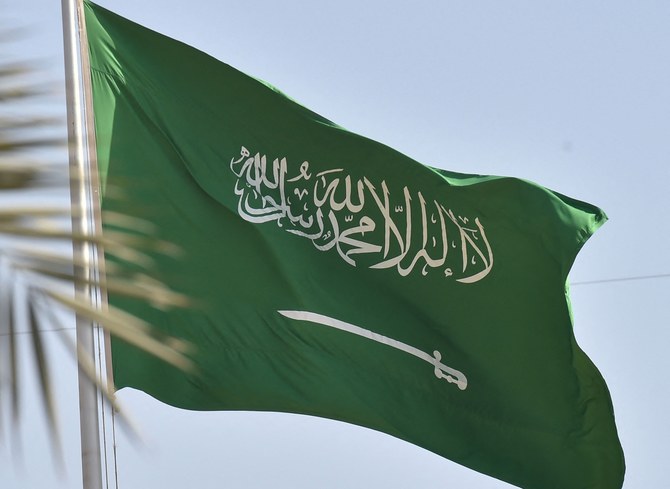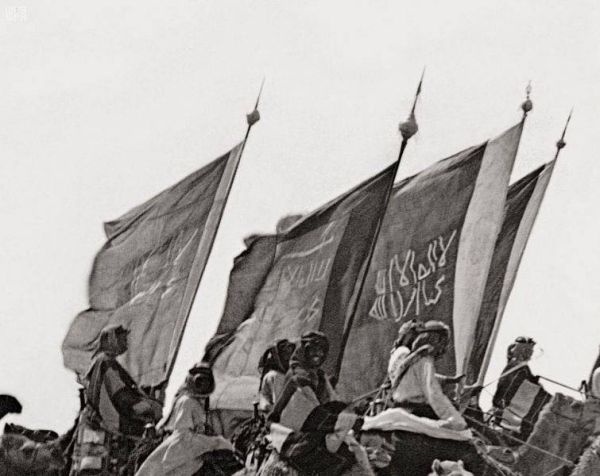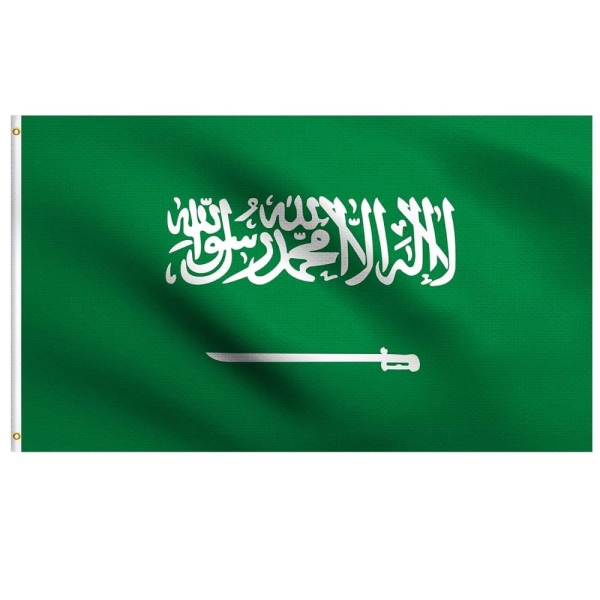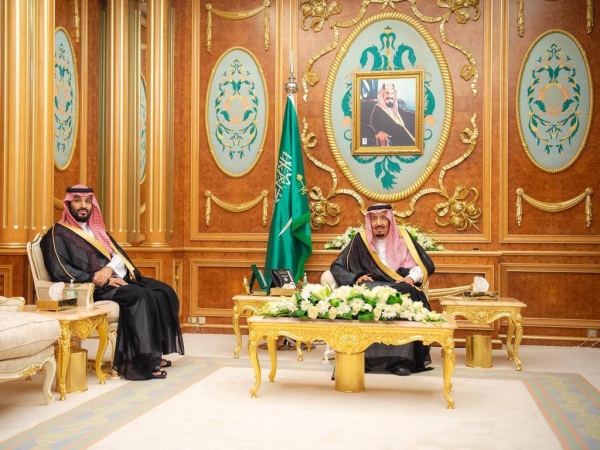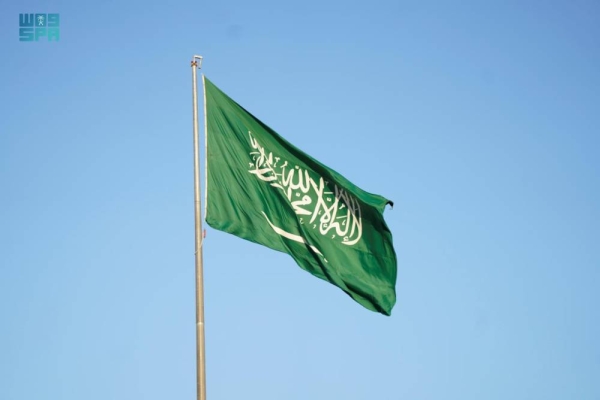
Saudi Arabia celebrates the Flag Day on Saturday, March 11. This is in line with a royal decree issued recently by Custodian of the Two Holy Mosques King Salman.
The King stated that the Flag Day will be celebrated on March 11 every year. The Monarch noted that the Flag Day coincides with the day March 11, 1937, when King Abdul Aziz, the founder of modern Saudi Arabia, approved the shape of the flag to confirm the great connotations of this flag that refer to growth, giving, unity and prosperity.
In his observation of the history of the Saudi Flag and its evolution, renowned researcher and historian the late Abdurahman Al-Ruwaished made the clarifications for the first time.
In his book titled “The history of the Saudi Flag: national flags, decorations and insignia”, he explained what could be called “the flag of banners, decorations and ranks,” as well as the concept and meaning of the flag in the Arabic language.
He stated that there are several words in Arabic that are synonymous to denote the word flag. These include Al-liwaa, Al-band, Al-bayraq, Al-darfas, Al-eqab, and Al-nasab, and all these imply a piece of colorful cloth tied to a pole.
The piece of cloth denotes symbols and references to something of great value and special meaning, and this great symbolic value is carried by the soldiers at the forefront of the army’s march and parades, as well as hoisted at government offices and facilities during holidays and festive occasions.
The Kingdom of Saudi Arabia chose the green color with the Islamic creed of monotheism “There is no God but Allah and Muhammad is the Messenger of God” in the middle, and under it is a drawn sword, and this is the flag inherited since the first Saudi state.
Al-Ruwaished pointed out that the Saudi Flag was inherited and went through evolutions until the framework of the flag came to a stable shape by the end of the era of King Abdul Aziz and continued throughout these years until to date.
The historian stated that he did not find any written script in the annals of Saudi history or a recorded text about the history of the Saudi flag in the first Saudi state, nor about its dimensions and measurements.
However, the researcher resorted to the sayings of many trustworthy people whose statements can be relied upon in this matter.
They included Prince Musaed Bin Abdul Rahman, Sheikh Muhammad Bin Abdullatif Al-Sheikh, Sheikh Muhammad Bin Saleh Al-Sheikh, Muhammad Bin Abdul Rahman Bin Obeikan, Abdullah Bin Ibrahim Al-Sheikh and Abdullah Bin Muhammad Al-Imran.
They all agreed that the Saudi flag was green and made of silk, and the phrase: “There is no God but Allah and Muhammad is the Messenger of God” was written on it, and it was tied to a simple flagpole.
It continued as it is during the reigns of the founder of the first Saudi state Imam Muhammad Bin Saud, his son Imam Abdul Aziz Bin Muhammad, and his son Imam Saud Bin Abdul Aziz, known as Saud Al-Kabeer, the great conqueror, and his son Abdullah Bin Saud.
This narrative was supported by what was mentioned in the rhymed words by the historian Hussein Bin Ghannam. This cannot be ruled out but rather it may be adding to the degree of certainty, especially since this is the form of flags and banners in the Islamic era throughout the ages.
At a time when the Anglo-French conflict escalated, Domingo Badia Lebelch came after pretending to be a Muslim and disguised himself under the name Haji Ali Beg Al-Abbasi to work for Napoleon III, and to investigate into the depths of the reform movement in Najd.
This agent arrived in Makkah in January 1807 AD, and then had the opportunity to witness the entry of Imam Saud’s army into Makkah. Al-Abbasi recorded the entry of 45,000 followers of Saud, while they were in their Ihram garments.
He watched the sheriff and his soldiers disappear in their castles, while the army of Saud and his followers crawled inside Makkah to perform the Umrah rituals, carrying a green flag embroidered on it in large white letters, the phrase: ‘There is no God but Allah, and Muhammad is the Messenger of God.”
The Swiss traveler John Lewis Burckhardt also mentioned, in his travelogue, about the Wahhabi Bedouins during his travels to the East. He talked about the military affairs of Imam Saud Bin Abdulaziz Bin Muhammad Bin Saud and his firm grip of power in the Arabian Peninsula and his conquests.
He pointed out that each sheikh or prince from among his princes had a special flag, and that Saud owned a number of different flags. He described that Saud’s tents featured elegance and beauty that were made in Damascus or Baghdad, and that they were of the black color that were common among the Arabs.
It should be noted that the first flag of Jihad in the first Saudi era was raised in 1157 AH (1744 AD) against all those who were hostile to the people of monotheism or insulted them. Similarly, the first army carrying the flag that was deployed was a small group of men who had a limited number of weapons.
It was also said that the first ruler of Diriyah from the House of Saud continued his rule for 40 years, and he carried the flag by himself or tasked one of his sons to do the same.
Ibn Bishr mentioned in his history book that Imam Abdul Aziz Bin Muhammad, the second ruler of the first Saudi state, and his son Imam Saud used to send their messengers to the heads of the tribes and allotted for them a specific day and a known place on a designated place for water, and they proceeded with flag and they installed it on the water resource so as to ensure that none of the tribal chiefs would be left behind.
Ibn Bishr stated in the biography of Imam Turki Bin Abdullah, who was the founder of the second Saudi state, the grandfather of the current royal family and the fifth grandfather of King Abdullah, that when Imam Turki wanted to embark on an expedition, he used to write to the princes of those places and chiefs of tribes asking them to come out on a specific day to a specific location.
Then he reinforced his war machines, army equipment, and horse fodder 15 days before his expedition and then he took out the flag and erected it near the door of the palace a day, two, or three days before his departure.
Imam Turki ordered the carrying of the flag and his son Faisal also followed his example in introducing the system of bringing out the flag and presenting it in front of him or setting it up in front of the palace.
For his part, Adnan Al-Turaif, a journalist-cum-researcher of history, mentioned that King Abdul Aziz, during the beginning of the phase of founding the third Saudi state, used the same flag that had used in the first and second Saudi states, and issued directives in 1902 to make some changes in the flag.




